Abstract
Objective
The aim of this study is to evaluate the effect of rest time (ten minutes) on muscular strength production during a training session under electrical stimulation.
Patients and methods
The isometric force output of the quadriceps femoris muscle was recorded during four sessions of stimulation of five minutes (15 maximal contractions: five seconds on and 15 seconds of rest), on 13 healthy adults. These four sessions are spaced out of ten minutes of recovery. The frequency of current is 100 Hz.
Results
At the 60th contraction, muscular force reaches 53 ± 7% of MVC. This value is significantly more important comparatively with a training session without rest time inside (27 ± 6% of MVC).
Conclusion
The efficiency of electrical stimulation to improve muscle strength seems to be dependent on number of contractions per session with a high level of force production (> = 60% de MVC). The protocol including intermediate periods of recovery seems more effective in order to produce a high level of force during all the training session.
Résumé
Objectif
L’objectif est de mettre en évidence l’effet de temps de récupérations longs (dix minutes) au cours d’une séance de stimulation électrique sur la force électro-induite.
Patients et méthode
La force maximale volontaire (FMV) et électro-induite isométrique du quadriceps fémoral de 13 sujets est mesurée lors d’une séance composée de quatre sessions de stimulation de cinq minutes espacées de dix minutes de récupération (15 contractions maximales électro-induites d’une durée de cinq secondes séparées de 15 secondes de repos). La fréquence de courant est de 100 Hz.
Résultats
La force à la 60 e contraction dans ce protocole, incluant trois phases de récupération, représente 53 ± 7 % de FMV. Cette valeur est significativement plus importante que celle obtenue avec 60 contractions, sans phases de récupération (27 ± 6 % de FMV).
Conclusion
Le nombre de contractions à une intensité suffisamment élevée (> = 60 % de FMV) par séance conditionne l’efficacité d’une stimulation électrique, visant à améliorer la force musculaire. Le protocole présenté dans cette étude, incluant des périodes de récupération intermédiaires semble plus efficace pour l’obtention d’une force élevée (60 % de FMV ou plus) pendant toute la durée de la séance.
1
English version
1.1
Introduction
Re-athletisation is important for many sports people. It consists of designing intermediate muscular programmes of training between the period of rehabilitation and the ordinary sports training or for the period of waiting for specific medicalized treatments. Whatever the field of application of the training, the methods used concerning the muscular reinforcement (containing exercises using body weight, additional loads or the electric stimulation of the muscles) must constantly evolve in order to allow an adaptation of the organism which is the most effective and the fastest possible.
In this context, electrostimulation seems to have the advantage of shortening the time of training .
The basic principles of traditional training for muscular force have been known for a long time . Training by electrostimulation is a good means of obtaining the maximum muscular contractions necessary to the improvement of the muscular force after a certain period of training . However, this method of training still suffers from heterogeneity from the methods used and thus the results obtained are sometimes contradictory. Several factors are at the origin of these differences: the position and the number of the electrodes, the frequency of the current, the percentage of muscular tension induced by the current compared to the voluntary maximum force, the duration of the sessions and the frequency of the exercise.
Goblet et al. did not obtain significant differences after six weeks of training . Each subject was involved four times per week at a rate of 20 electro-induced muscular contractions of 15 seconds separated from 50 seconds of rest. The intensity corresponded to the maximum tolerated by each subject. The total duration of the meetings was 21 minutes. Two rectangular electrodes were placed on the proximal and distal parts of the rectus femoris. Kramer and Semple trained the quadriceps of ten female subjects during 12 sessions of electric stimulation by means of a current with 100 Hz . The mode of exercise was 20 maximum contractions of ten seconds separated from 50 seconds of rest. Two electrodes were placed on the femoral nerve and the distal portion of the rectus femoris. The total duration of the meetings was 20 minutes. The gain of force obtained was of 9.2%. Parker et al. also observed that the intensity of the electro-induced muscular contractions has a significant effect on the importance of the increase of the electro-induced muscular force at the end of exercise . The modes of stimulations used are often based on the principle that, to be effective, the muscular contraction must be maximal during all the period of stimulation. The optimal duration of each stimulation and the rest intervals between them were studied in order to minimize muscular fatigue and consequently to optimize the effectiveness of the contractions. Kots and Chwilon, after various tests, noted that fatigue appeared quickly after 12.5 seconds of stimulation. The duration of stimulation was thus fixed at ten seconds with ten, 20, 30, 40 or 50 seconds of intermediate rest . The most effective interval for recovery proved to be 40–50 seconds. An interval of 40 seconds and a number of ten contractions were recommended.
For Dehail et al., the effectiveness of the electromyostimulation remains insufficiently demonstrated . In a previous study , we showed that the frequency of 100 Hz is optimal for the training of force, but it causes fatigue, after the 15th contraction. We had made the assumption that the 20-minute protocol of electric stimulation used in a great number of proposals for a training, would not be suitable insofar as it does not make it possible to generate an important force during most of the meeting if it is not interrupted by sufficient pauses. It would be preferable to use four sessions of 15 contractions (each one five minutes duration) separated by ten minutes of recovery. This proposal goes in the direction of the observations of Kots and Chwilon even if the shapes of current used are not the same .
However, there is not, to our knowledge, work making it possible to estimate the evolution of the force during such a protocol.
1.2
Patients and methods
Thirteen subjects, students at the University Blaise-Pascal of Clermont-Ferrand (age 25 ± 3 years, height 171 ± 6 cm, weight 69 ± 7 kg), without pathology of the type orthopedic, neurological or vascular, took part in this noninvasive study. The majority of them practiced sports activity of leisure, or competition at the departmental level. The participation of the subjects was voluntary after they were informed and gave their consent. The subjects were free to withdraw from the study at any time. The procedure used is in agreement with the declaration of Helsinski. The subject sat on a seat making it possible to evaluate the force of extension of the right leg on the thigh. The depth of the seat and the position of the sensor are adjustable according to subjects’ morphology ( Fig. 1 ). The angle of inclination of the trunk was fixed at 120° and the inflection of the leg at 60° ( Fig. 1 ), which corresponds to the position where a maximum force can be produced . The force sensor was attached to the subject’s right ankle, perpendicular to the longitudinal axis of the leg, making it possible to record the isometric contractions of the quadriceps. The pelvis was also attached to the armchair by an adjustable abdominal belt, in order to limit parasitic movements.
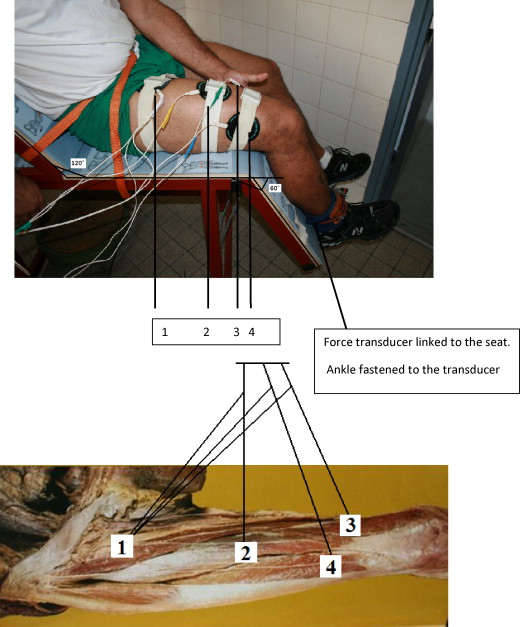
The measuring equipment used makes it possible to record the muscular force at a frequency of 50 Hz without interruption via a National Instruments DAQCard-AI-16th-4 acquisition card. Data acquisition software and data processing specific to the study were developed at the laboratory (Matlab ® computer programming language).
A screen made it possible for the subjects to visualize in real-time a representation of the force developed. A “Magic Form” stimulator delivered rectangular biphasic currents, the duration of the hemi phases was of 300 μs, with a frequency fixed at 100 Hz. The intensity corresponded to the maximum tolerable intensity. The stimulation proposes a scale from 1 to 100 mA. We used four surface electrodes made out of elastomer; three were positioned on the driving points of the muscles vastus lateralis, vastus medialis and rectus femoris and the fourth one over the femoral nerve on the proximal part of the thigh ( Fig. 1 ) . A specific warm-up of the extensors of the leg on the thigh was carried out for three minutes (dynamic and isometric contractions below maximum), followed by three minutes of rest before each experimentation. Each subject was then subjected to a test of isometric maximal voluntary force known as of beginning of meeting (MVC). Three isometric maximal voluntary contractions of five seconds duration, separated by three minutes of rest were required. The average of the three tests was retained as being the MVC of reference. A period of rest of five minutes was allocated before undertaking the electric period of stimulation. Four sessions of five minutes stimulation (15 induced maximal electro-contractions of 15 seconds separated by 15 seconds duration of rest) were necessary to the study. These four sessions were separated by ten minutes of recovery ( Fig. 2 ).
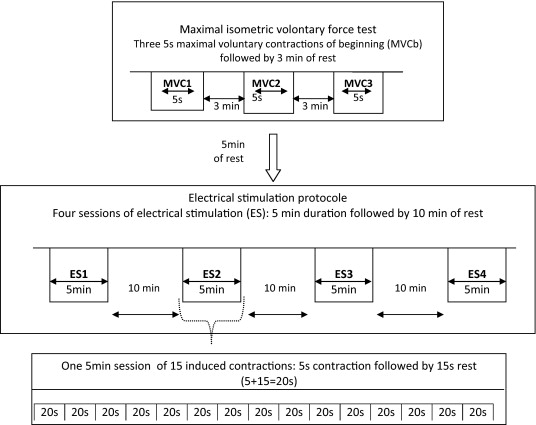
The forces induced under electric stimulation were recorded for the four required sessions. The induced force values of beginning (IFb) and end of appointment (IFe) were recorded.
1.3
Statistical analysis
A one way variance analysis (Anova) followed by a “post-hoc” analysis of Turkey was used to compare the percentage of the electro-induced maximum forces at beginning of each session (IFb1, IFb2, IFb3 and IFb4) with respect to the maximum voluntary force, as well as the percentage of the electro-induced forces at end of each session (IFe1, IFe2, IFe3 and IFe4) with respect to the maximum voluntary force.
1.4
Results
All the contractions obtained either by electric stimulation, or by voluntary contraction were of tetanic type ( Figs. 3 and 4 ). The electro-induced maximum forces at the beginning of session (IFb1, IFb2, IFb3 and IFb4) were significantly different from the voluntary maximum forces of beginning of appointment (MVC) ( Fig. 5 ). Those respectively accounted for 72 ± 5%, 71 ± 5%, 70 ± 6% and 68 ± 5% of MVC. These values were not significantly different from each other ( P > 0.5), ( Fig. 6 ). The intensity of the contraction decreased significantly with the 15th stimulation for all the sessions ( P < 0.001). IFe1 = 59 ± 7%, IFe2 = 58 ± 6%, IFe3 = 56 ± 6% and IFe4 = 53 ± 7% of MVC ( Fig. 7 ). These values did not present significant differences between them ( Fig. 6 ).
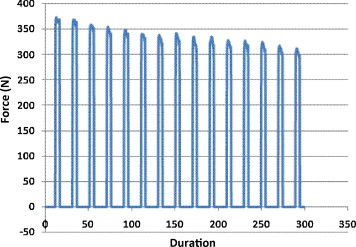
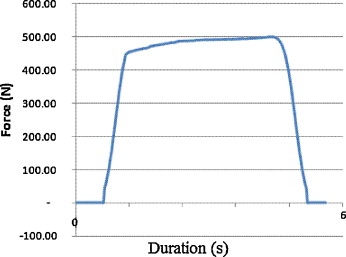
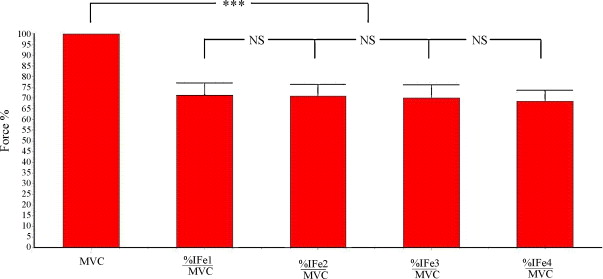
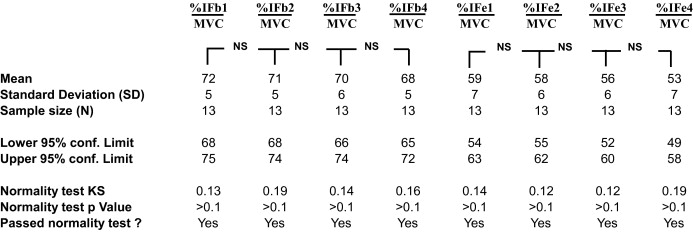
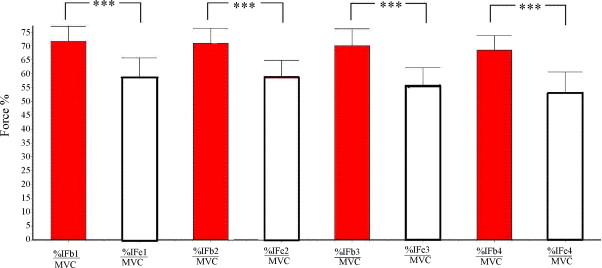
1.5
Discussion
This study made it possible to compare the intensity of the force of the muscular contractions produced during four sessions of electric stimulation of 15 maximum contractions separated by ten minutes of recovery. Each contraction of five-second duration was separated from following by 15 seconds of rest. The duration of impulse was 300 μs. The increase in this value can make it possible to reach higher thresholds of force, but that also increases the pain felt . For the comfort of the subjects, we did not adopt this solution. The intensity 57 ± 10 mA was determined by the tolerance of the subjects. We chose this option because it corresponds to what occurs in practice when subjects decide to use electric stimulation in complement of their training. It does not appear realistic to fix an intensity common to all subjects taking into account the differences of morphology, body impedance and tolerance to the pain that may accompany the passage by the current. Our objective was to obtain a maximum induced electro-force. To overcome the differences in production of individual force related to the intensity of individualized stimulation, we thus chose to standardize all the values to MVC. The standard deviations are about 5%, confirming the homogeneity of the responses. In a former study, we proposed that the frequency of 100 Hz be reserved for the training of the maximum muscular force in sports training . The results of IFb confirmed results from the former study. With a frequency of 100 Hz, the electro-induced force at the beginning reached in this study 72% of the voluntary maximum force and 71% of MVC for the previous study . Porttmann obtained 79% of MVC . The fact that there is no significant difference between IFb1, IFb2, IFb3 and IFb4, respectively, 72 ± 5%, 71 ± 5%, 70 ± 6% and 68 ± 5% of MVC, shows that the electro-induced force is restored in its quasi-totality at the end of ten minutes of recovery. There does not exist either any significant differences between IFe1, IFe2, IFe3 and IFe4, respectively, 59 ± 7%, 58 ± 6%, 56 ± 6% and 53 ± 7% of MVC. With regard to training, it is necessary to reach a sufficiently important threshold of force (expressed in percentage of MVC) during the appointments to anticipate an improvement of the force of more than 60% of MVC . If we start from the postulate that the force must be higher than 60% of MVC to hope for gains of force, in this protocol, we obtained 39 contractions out of 60 higher or equal to 60% of MVC. The other contractions remained for the majority of them higher than 50% of MVC ( Fig. 5 ). In the previous study, without fractionation of the appointment, we obtained only 15 contractions higher than 60% of MVC, which is in fact the equivalent of the first session in this protocol . In the same way, the force induced at the 60th contraction represents 53 ± 7% of MVC, whereas it was only of 27 ± 6%. The average intensity of muscular contraction is higher when one includes intermediate phases of rest during a training session. There remains a significant difference between first and the 15th contraction of each of the four sessions composing the appointment ( Fig. 5 ); however, we approach the optimal conditions allowing to hope for a significant force gain following a plan of training of several appointments.
For these two studies, the studied population was identical, the 13 students of the University Blaise-Pascal France having taken part in this study also took part in the previous study . This result validates our assumption. This increase in the force is due to restoration of the reserves of ATP-CP during the ten minutes of intermediate rest . The effectiveness of electric stimulation having for objective the improvement of the maximum muscular force depends on the number of contractions per session. The electric protocol of stimulation of continuous contractions during 20 minutes which is used the most in a great number of proposals for training does not seem to be the most suitable. It would be preferable to use four sessions of 15 contractions (that is to say one five minutes duration) separated by ten minutes of recovery for a training session. It now remains to verify the impact of such a protocol of stimulation not only during one appointment but over a period of exercise.
1.6
Conclusion
The protocol presented in this study, including significant intermediate periods of recovery of substantial duration (ten minutes), seems effective to maintain a high percentage of force throughout a training session. This result is to be put in parallel with a study for which an identical protocol for the parameters of stimulation, carried out on the same population, comparing 60 contractions but without intermediate pauses did not make it possible to maintain throughout the training session a satisfactory level of contraction to hope to obtain significant gains of force . This is particularly important within the framework of a re-athletisation for patients hoping to recover capacities of force compatible with their sporting specialties as fast as possible.
2
Version française
2.1
Introduction
La réathlétisation concerne un très large public. Il s’agit de concevoir des programmes d’entraînement musculaires intermédiaires entre la période de rééducation et l’entraînement sportif ordinaire ou pendant la période d’attente de traitements médicalisés spécifiques. Quel que soit le champ d’application de l’entraînement, les méthodes utilisées concernant le renforcement musculaire (à base d’exercices utilisant le poids de corps, des charges additionnelles ou la stimulation électrique des muscles) doivent constamment évoluer afin de permettre une adaptation de l’organisme qui soit la plus efficace et la plus rapide possible.
Dans ce contexte, l’électrostimulation semble présenter comme avantage le raccourcissement du temps d’entraînement .
Les principes de base de l’entraînement classique de la force musculaire sont connus depuis bien longtemps . L’entraînement par électrostimulation est un bon moyen d’obtenir les contractions musculaires maximales nécessaires à l’amélioration de la force musculaire après une certaine période d’entraînement . Toutefois, cette méthode d’entraînement souffre encore de l’hétérogénéité des moyens utilisés et donc les résultats obtenus sont parfois contradictoires. Plusieurs facteurs sont à l’origine de ces différences : le placement et le nombre des électrodes, la fréquence du courant, le pourcentage de la tension musculaire induite par le courant par rapport à la force maximale volontaire (FMV), la durée des séances et la fréquence de l’entraînement.
Goblet et al. n’ont pas obtenu de différences significatives après six semaines d’entraînement . Chaque sujet était entraîné quatre fois par semaine à raison de 20 contractions musculaires électro-induites de 15 secondes séparées de 50 secondes de repos. L’intensité correspondait au maximum tolérée par chaque sujet. La durée totale des séances était de 21 minutes. Deux électrodes rectangulaires étaient placées sur la portion proximale et distale du droit fémoral. Kramer et Semple ont entraîné le quadriceps de dix sujets féminins durant 12 séances de stimulation électrique au moyen d’un courant à 100 Hz . Le régime d’entraînement était 20 contractions maximales de dix secondes séparées de 50 secondes de repos. Deux électrodes étaient placées sur le nerf fémoral et la portion distale du droit fémoral. La durée totale des séances était de 20 minutes. Le gain de force obtenu était de 9,2 %. Parker et al. ont également observé que l’intensité des contractions musculaires électro-induites a un effet significatif sur l’importance de l’augmentation de la force musculaire électro-induite à la fin d’entraînement . Les régimes de stimulations utilisés partent souvent du principe que pour être efficace, la contraction musculaire doit être maximale durant toute la période de stimulation. La durée optimale de chaque stimulation et les intervalles de repos entre elles ont été étudiés afin de minimiser la fatigue musculaire et par conséquent optimiser l’efficacité des contractions. Kots et Chwilon, après divers essais, ont constaté que la fatigue s’installait rapidement après 12,5 secondes de stimulation. La durée de stimulation a donc été fixée à dix secondes, avec dix, 20, 30, 40 ou 50 secondes de repos intermédiaire . L’intervalle le plus efficace pour la récupération s’est avéré être 40–50 secondes. Un intervalle de 40 secondes et un nombre de dix contractions ont été préconisé.
Pour Dehail et al., l’efficacité de l’électromyostimulation reste insuffisamment démontrée . Dans une étude précédente , nous avons montré que la fréquence de 100 Hz est optimale pour l’entraînement de force mais elle provoque une fatigue très rapide, après la 15 e contraction. Nous avions émis l’hypothèse que le protocole de stimulation électrique de 20 minutes utilisé dans un grand nombre de propositions d’entraînement ne serait pas approprié dans la mesure où il ne permet pas de générer une force importante pendant une grande partie de la séance s’il n’est pas entrecoupé de pauses suffisantes. Il serait préférable d’utiliser quatre séances de 15 contractions (soit d’une durée de cinq minutes) séparées de dix minutes de récupération. Cette proposition va dans le sens des constatations de Kots et Chwilon, même si les formes de courant utilisées ne sont pas les mêmes .
Cependant, il n’existe pas à notre connaissance de travaux permettant d’estimer l’évolution de la force au cours d’un tel protocole.
2.2
Patients et méthodes
Treize sujets étudiants à l’université de Blaise-Pascal de Clermont-Ferrand (âge 25 ± 3 ans, taille 171 ± 6 cm, poids 69 ± 7 kg), sans pathologie de type orthopédique, neurologique ou vasculaire, ont participé à cette étude non invasive. Ils pratiquent pour la plupart une activité sportive de loisir ou de compétition au niveau départemental. La participation des sujets était volontaire après information et avoir donné leur consentement. Les sujets étaient libres de se retirer de l’étude à tout moment. La procédure utilisée est en accord avec la déclaration d’Helsinski. Le sujet était assis sur un siège permettant d’évaluer la force d’extension de la jambe droite sur la cuisse. La profondeur de l’assise et la position du capteur sont réglables selon sa morphologie ( Fig. 1 ). L’angle d’inclinaison du tronc était fixé à 120° et la flexion de la jambe à 60° ( Fig. 1 ), ce qui correspond à la position où une force maximale peut être produite . Le capteur de force était solidarisé à la cheville droite du sujet, perpendiculairement à l’axe longitudinal de la jambe permettant d’enregistrer les contractions isométriques du quadriceps. Le bassin était également attaché au fauteuil par une ceinture abdominale réglable, afin de limiter les mouvements parasites.









